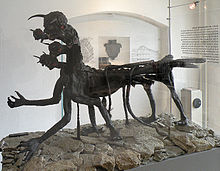Seven miracles (Jena)
Seven sights of the Thuringian university town of Jena are called the Seven Wonders of Jena ( Latin septem miracula Jenae ) .
history
In 1558 the Alma Mater Jenensis, soon one of the most famous places of study in Germany, was founded. During their stay in the city, the university graduates from half of Europe learned of a total of seven curiosities that were considered evidence of their actual presence in Jena, but were kept secret from the public. A verse written in Latin from this period, which enumerates the seven miracles, reads: "Ara, caput, draco, mons, pons, vulpecula turris, Weigeliana domus, septem miracula Jenae." Uninitiated could not guess the meaning of this saying. With this unusual means, the university protected itself from impostors and fraudsters who could have damaged the university's reputation.
Five of the “seven miracles” described below still exist today.
Ara - the altar underpass of the city church
One of the seven miracles is Ara , a vaulted passage under the altar of the town church , which at that time was the only way to get to the Cistercian monastery founded in 1301 behind this church . The passage has a height of 3.5 meters and a width of 3 meters. This architectural curiosity in church construction is very rare.
Caput - the Schnapphans figure on the town hall clock
Every hour on the hour, the Schnapphans (Hans von Jena) at the town hall snaps for a golden ball on a stick held by a pilgrim standing on a pedestal to the left of the clock. The ball is supposed to represent one of the famous Thuringian dumplings . Legend has it that Jena would go under if he could catch it. To the right of the clock is an angel who holds a bell in his hands in front of his body. This figure moves at the quarter-hour strike. The original Schnapphans can be seen today in the city museum. A copy "snaps" at the town hall today. Only the very lean (hungry) head of the Schnapphans can be seen at the town hall . Caput is the Latin word for the head.
Draco - the seven-headed dragon
A dragon statue (lat. Draco , the dragon) with seven heads, four legs, two arms and four tails was made by Jena students at the beginning of the 17th century, probably as a joke, from animal bones, wire and paper mache; Draco can be admired today in the city museum.
Mons - the mountain "Jenzig"
The mountain (lat. Mons ) means the most striking mountain of Jena, the Jenzig , a 385 meter high shell limestone mountain with a striking bare point, the so-called nose.
Pons - the old Camsdorfer bridge
The old Camsdorfer Brücke (lat. Pons ), a stone arch bridge , existed with its 9 arches since around 1480 and had to give way to a new bridge in 1912. There was also a chapel on top of it, and when it was built it was one of the largest bridges in Germany. The newly built bridge was blown up in 1945 by German troops, which was actually pointless as the Americans had already crossed the Saale at another point. In the Soviet Occupation Zone (1946), the bridge was rebuilt with the help of the Soviet occupiers and was therefore called the "Bridge of German-Soviet Friendship". It was the first building in Jena to be rebuilt after the war. The new Camsdorf Bridge had to be renovated in 2005. There are plans for the citizens of Jena to rebuild the small chapel on the bridge with an angel on the roof based on the coat of arms of a Munich artist. However, there is only one photo of this striking work of art.
Vulpecula Turris - The Fox Tower
The Fuchsturm (Latin Vulpecula Turris ) is an old keep on the local mountain , which belonged to Kirchberg Castle.
Weigeliana Domus - the Weigel house
The last miracle of Jena was the Weigel House (Latin Weigeliana Domus ), demolished in 1898 to widen a street . It stood by the town church and owed its fame to the mathematics professor Erhard Weigel from the 17th century. He had many technical refinements built in, including a wine pipe from the cellar, an elevator with pulley principle and long tubes through the whole house through to the roof for stargazing even during the day. At the time, the "Weigel'sche Haus" was a landmark that was well known far beyond the city limits. The students used the saying: "If you didn't see Weigel's house, you haven't been to Jena."
Web links
- "The seven wonders of Jena" on the website of the city of Jena
Individual evidence
- ^ Ludwig Bechstein: Deutsches Sagenbuch , 1853, p. 505.
- ↑ a b Jena . In: Paul Lehfeld (Hrsg.): Architectural and art monuments of Thuringia. Grand Duchy of Saxony-Weimar-Eisenach. District court district Jena . Issue 1. Gustav Fischer, Jena 1888, Die Jenaer Stadtkirche, p. 84 .
- ↑ Jena . In: Paul Lehfeld (Hrsg.): Architectural and art monuments of Thuringia. Grand Duchy of Saxony-Weimar-Eisenach. District court district Jena . Issue 1. Gustav Fischer, Jena 1888, Das Rathhaus, p. 131 .
- ↑ Jena . In: Paul Lehfeld (Hrsg.): Architectural and art monuments of Thuringia. Grand Duchy of Saxony-Weimar-Eisenach. District court district Jena . Issue 1. Gustav Fischer, Jena 1888, Die Camsdorfer Brücke, p. 153 .
- ↑ Jena . In: Paul Lehfeld (Hrsg.): Architectural and art monuments of Thuringia. Grand Duchy of Saxony-Weimar-Eisenach. District court district Jena . Issue 1. Gustav Fischer, Jena 1888, Das Weigelsche Haus, p. 148 .






